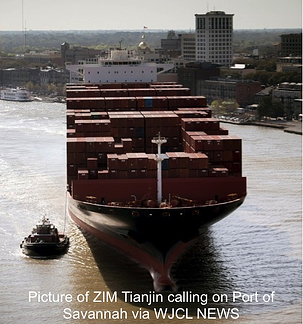 For the first time ever, a container ship with a capacity larger than 10,000 TEUs (twenty-foot-equivalent units) called upon U.S. East Coast ports this week.
For the first time ever, a container ship with a capacity larger than 10,000 TEUs (twenty-foot-equivalent units) called upon U.S. East Coast ports this week.
Such megaships have called upon the West Coast, but this may be another sign of East Coast ports gaining on the West Coast.
With all the congestion at West Coast ports that was extremely exacerbated by the long and bitter contract negotiations between the International Longshore & Warehouse Union (ILWU) and the Pacific Maritime Association (PMA), demand increased at East Coast ports with shippers diverting cargo.
It was that increased demand of shippers diverting cargo from West Coast ports that led to this East Coast record setting ship, according to a Joseph Bonney written article in the Journal of Commerce:
“The ship was an extra loader deployed to meet demand following congestion at West Coast ports.”
So what was the ship?
Zim Tianjin:
- 10,060-TEU
- 1,145 feet long
- 150 feet wide
- 49.5 feet maximum draft
To put the size of the Zim Tianjin in perspective, Christopher Buchanan reported in a WJCL News article, “Stood on end, it would stand nearly as tall as the Empire State Building – 1,454 feet, including its antenna.”
In fact, the title of that WJCL News article is Empire State Building-sized ship docks in Savannah.
Before visiting the Port of Savannah, the Zim Tianjin called at GCT Bayonne in the Port of New York and New Jersey.
Clearance for megaships of this size and bigger is an issue for East Coast ports, and for ports around the world, really. There are many projects in the works to make it possible for the huge ships, which are now the trend in the international shipping industry, to be able to call on ports.
In fact, that JOC article shares the following:
…the Bayonne terminal, the only major New York-New Jersey terminal outside the Bayonne Bridge, which has a 151-foot-vertical clearance that limits the size of ships that can call other port terminals.
The bridge’s clearance is scheduled to be raised to 215 feet in 2016, the same year that larger locks are scheduled to open at the Panama Canal. Those developments are expected to result in calls by larger ships at East Coast ports.
New York-New Jersey is also nearing completion of work to deepen its port channels to 50 feet.
The WJCL article also spoke of projects to allow the East Coast, and the Port of Savannah in particular, to handle the larger ships they’re expecting to see with the expansion of the Panama Canal:
“The economy of scale achieved by Super Post-Panamax vessels is the reason we’re seeing more of them in Savannah – a trend that will only continue after an expanded Panama Canal opens in 2016.”
In order to better accommodate Super Post-Panamax vessels, the Savannah Harbor Expansion Project will deepen the main river channel to 47 feet at low tide (averaging 54 feet at high tide).
In March, the U.S. Army Corps of Engineers issued a $134.5 million contract that will mark the start of dredging.
The contract covers deepening the outer harbor, extending 18.5 miles into the Atlantic Ocean.
Dredging the outer harbor constitutes about half of the project to deepen the 40-mile shipping channel and harbor from deep ocean to Garden City.
Georgia has approved $266 million in bonds to cover the state’s projected share of construction costs.
As the $706 million expansion moves forward, construction funding will shift to federal dollars. Better accommodating larger, more efficient vessels such as the Tianjin will save U.S. companies moving goods through Savannah 20 to 40 percent on transportation.
As the East Coast continues to increase its ability to handle larger ships and makes moves like trying to work out long term labor contracts three years before the current contract expires, West Coast ports will have to work hard to regain shippers’ confidence and maintain their market share.
